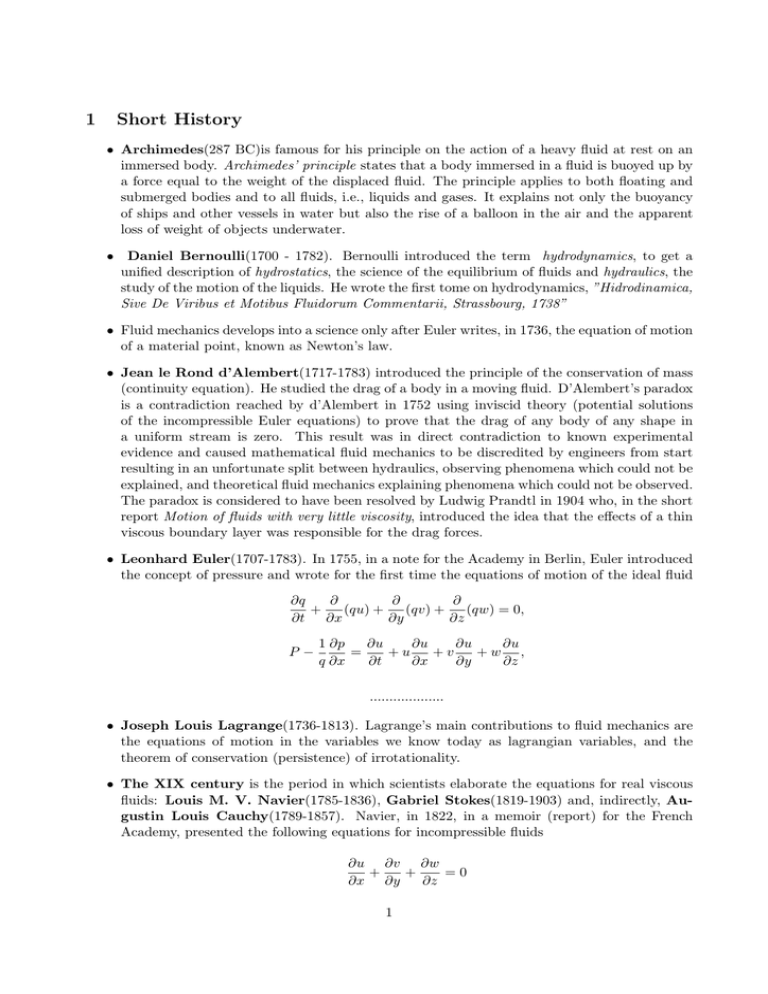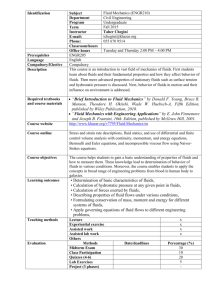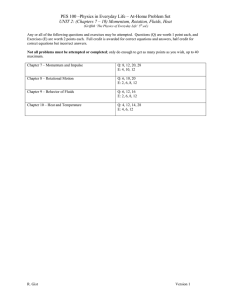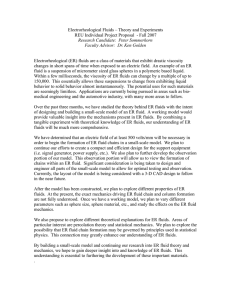1 Short History
advertisement

1 Short History • Archimedes(287 BC)is famous for his principle on the action of a heavy fluid at rest on an immersed body. Archimedes’ principle states that a body immersed in a fluid is buoyed up by a force equal to the weight of the displaced fluid. The principle applies to both floating and submerged bodies and to all fluids, i.e., liquids and gases. It explains not only the buoyancy of ships and other vessels in water but also the rise of a balloon in the air and the apparent loss of weight of objects underwater. • Daniel Bernoulli(1700 - 1782). Bernoulli introduced the term hydrodynamics, to get a unified description of hydrostatics, the science of the equilibrium of fluids and hydraulics, the study of the motion of the liquids. He wrote the first tome on hydrodynamics, ”Hidrodinamica, Sive De Viribus et Motibus Fluidorum Commentarii, Strassbourg, 1738” • Fluid mechanics develops into a science only after Euler writes, in 1736, the equation of motion of a material point, known as Newton’s law. • Jean le Rond d’Alembert(1717-1783) introduced the principle of the conservation of mass (continuity equation). He studied the drag of a body in a moving fluid. D’Alembert’s paradox is a contradiction reached by d’Alembert in 1752 using inviscid theory (potential solutions of the incompressible Euler equations) to prove that the drag of any body of any shape in a uniform stream is zero. This result was in direct contradiction to known experimental evidence and caused mathematical fluid mechanics to be discredited by engineers from start resulting in an unfortunate split between hydraulics, observing phenomena which could not be explained, and theoretical fluid mechanics explaining phenomena which could not be observed. The paradox is considered to have been resolved by Ludwig Prandtl in 1904 who, in the short report Motion of fluids with very little viscosity, introduced the idea that the effects of a thin viscous boundary layer was responsible for the drag forces. • Leonhard Euler(1707-1783). In 1755, in a note for the Academy in Berlin, Euler introduced the concept of pressure and wrote for the first time the equations of motion of the ideal fluid ∂q ∂ ∂ ∂ + (qu) + (qv) + (qw) = 0, ∂t ∂x ∂y ∂z P− 1 ∂p ∂u ∂u ∂u ∂u = +u +v +w , q ∂x ∂t ∂x ∂y ∂z ................... • Joseph Louis Lagrange(1736-1813). Lagrange’s main contributions to fluid mechanics are the equations of motion in the variables we know today as lagrangian variables, and the theorem of conservation (persistence) of irrotationality. • The XIX century is the period in which scientists elaborate the equations for real viscous fluids: Louis M. V. Navier(1785-1836), Gabriel Stokes(1819-1903) and, indirectly, Augustin Louis Cauchy(1789-1857). Navier, in 1822, in a memoir (report) for the French Academy, presented the following equations for incompressible fluids ∂u ∂v ∂w + + =0 ∂x ∂y ∂z 1 P− ∂ρ ∂u ∂u ∂u ∂u ∂2u ∂2u ∂2u = ρ( +u +v + w ) − ²2 ( 2 + 2 + 2 ) ∂x ∂t ∂x ∂y ∂z ∂x ∂y ∂z ................... Influenced by Cauchy (who in 1829 wrote the general equations for continuum media), but without knowing about Navier, Stokes obtained, in 1845, the final form of the equations of motion of viscous fluids. He is considered, by most scientists, as the founder of the modern theory of viscous fluids. • Major contributions to the development of fluid mechanics in the XIX century have been brought by William Rankine(1820-1872), with studies on the theory of sources and vortices, Hermann von Helmholtz(1821-1894), who put Euler’s equations in a new form (Helmholtz’s equations), appropriate for theoretical studies, and set up the vortex motion theory, as well as the theory of surfaces with discontinuities. Other contributions to the development of fluid mechanics during this period are due to Robert Gustav Kirchhoff (1824-1887), who extended the theory of Helmholtz to the study of liquid jets, Osborne Reynolds(18421912), who studied the motion of viscous fluids, introducing the concepts of laminar and turbulent motion, Nicolaie Egorovich Jukovsky(1847-1921) with his theory on the motion of ideal fluids in the presence of an airfoil. Horace Lamb wrote the famous Treatise on the Mathematical Theory of the Motion of Fluids. Constantly in use since its first publication in 1892, this book is the definitive reference work for all fluid dynamicists. • The XX century. Stimulated by the work of Helmholtz and Kirchhoff, Levi Cività(18731941), Sergey Alexeyevich Chaplygin(1869-1942), Pierre Henry Villat(1879-1972) and other scientists have developed the theory of motion of ideal fluids in the presence of discontinuity surfaces. Cività and Villat have studied incompressible fluids, as well as the theory of gravitational waves, while Chaplygin worked on compressible fluids. The research in aerodynamics developed especially after the first world war, with the work of Ludwig Prandtl on the first 3-dimensional wing profile, as well as on turbulence and boundary layer, Theodor von Kármán(1881-1963), Prandtl’s disciple and Adolf Busseman(1901). An important contribution in the study of viscous fluids is due to Carl Wilhem Oseen(18791944), who introduced the mathematical model known today as Oseen’s model. The macroscopic theory is based on the hypothesis that fluids are continuous media and the equations of motions are postulated in the form of principles, their justification being based on experience. The microscopic theory considers the fluid as an ensemble of discrete material points whose motion is governed by Newton’s law. This is the so called kinetic molecular theory, initiated by James Clerk Maxwell(1831-1879) and Ludwig Boltzman(1844-1906), and was intensively developed during last century, when the discrete character of the matter started to be well understood. We mention here the reference book by S. Chapmann and T. G. Cowling, The Mathematical Theory of Nonuniform Gases, in 1939, who stimulated further research on microscopic phenomena. • After the second world war there was an increasing interest in the study of the fourth state of matter, plasma. The first mathematical theory to model plasma is magnetohydrodynamics (MHD), the study of electrically conducting fluids in the presence of a magnetic field. Historically, Faraday was the first to study such fluids. He carried out experiments at Waterloo 2 Bridge, measuring current from the flow of the Thames in the Earth’s magnetic field and trying to obtain electrical current from Thames river, electrically conducting due to sea streams. The magnetohydrodynamics has been applied in astrophysics after 1940, in the study of the interstellar gas, ionized due to cosmic radiations and influenced by the magnetic field of astrophysical bodies. In a series of publications, between 1940 and 1950, the Swedish physicist Hannes Alfvèn underlined the fact that a perturbation in such a gas propagates in the form of a specific wave (called today Alfvèn wave). For this research Alfvèn received in 1970 the Nobel Prize. The study of MHD will develop especially after 1950, when plasma could be reproduced in the laboratory. • open problems, new directions and perspectives in fluid mechanics - turbulence, computational fluid dynamics, complex fluids 3




